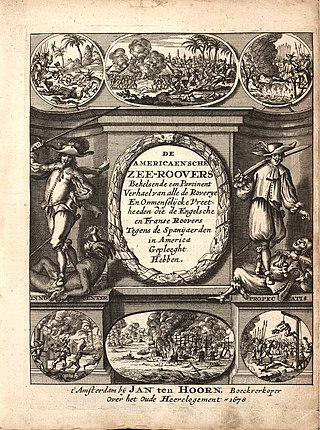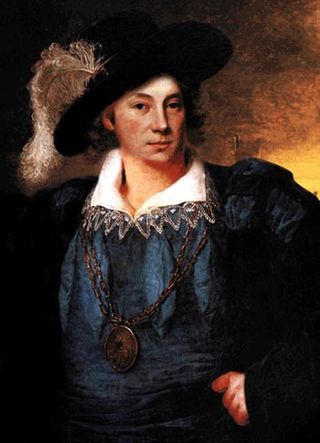Related Research Articles

Buccaneers were a kind of privateer or free sailors particular to the Caribbean Sea during the 17th and 18th centuries. First established on northern Hispaniola as early as 1625, their heyday was from the Restoration in 1660 until about 1688, during a time when governments in the Caribbean area were not strong enough to suppress them.

Alexandre Olivier Exquemelin was a French, Dutch or Flemish writer best known as the author of one of the most important sourcebooks of 17th-century piracy, first published in Dutch as De Americaensche Zee-Roovers, in Amsterdam, by Jan ten Hoorn, in 1678.
This timeline of the history of piracy in the 1680s is a chronological list of key events involving pirates between 1680 and 1689.
David Marteen was a Dutch privateer and pirate best known for joining Henry Morgan’s raids against Spanish strongholds in present-day Mexico and Nicaragua. He is also the subject of a popular buried treasure legend.

Laurens Cornelis Boudewijn de Graaf was a Dutch pirate, mercenary, and naval officer in the service of the French colony of Saint-Domingue during the late 17th and early 18th century.
John Morris was an English buccaneer active in the Caribbean during the 1660s and early-1670s. His son, John Morris the Younger, held a command of his own ship during his father's later expeditions against Portobelo and Maracaibo. John Morris the Younger was one of the commanders killed in an explosion during a party on board Henry Morgan's flagship in 1670.
Cornelius Essex was a buccaneer and privateer best known for sacking Spanish Puerto Bello as part of a larger contingent of pirates.
Jelles de Lecat was a Dutch pirate and buccaneer who sailed for and against both the English and Spanish. He served with Henry Morgan and was often called "Yellahs," "Yallahs," or “Captain Yellows.”
Jacob Evertson was a Dutch buccaneer and pirate active in the Caribbean. He escaped Henry Morgan and sailed with Jan Willems for several years.
Philip Fitzgerald was an Irish pirate and privateer who served the Spanish in the Caribbean.
James Browne was a Scottish pirate and privateer active in the Caribbean. He is best known for his hasty execution and its effect on colonial Jamaican government.

Jonathan Barnet was an English privateer in the Caribbean, best known for capturing pirates Calico Jack, Anne Bonny, and Mary Read. The Assembly of the Colony of Jamaica gave him a financial reward, and a large estate in the parish of St James worked by African slaves.

Edmund Cooke was a merchant captain, buccaneer, and pirate. He is best known for sailing against the Spanish alongside Bartholomew Sharp, John Coxon, Basil Ringrose, Lionel Wafer, and other famous buccaneers. Cooke's flag was red-and-yellow striped and featured a hand holding a sword.
Francis Witherborn was an English buccaneer, privateer, and pirate active in the Caribbean. He is best known for his brief association with Henry Morgan.
Thomas Freeman was an English buccaneer and pirate active in the Caribbean. He is best known for attacking the Spanish alongside Henry Morgan, David Marteen, and John Morris.
Jacob Fackman was an English buccaneer and pirate active in the Caribbean. He is best known for attacking the Spanish alongside Henry Morgan, John Morris, and David Marteen.
Edward Dempster was a buccaneer and privateer active in the Caribbean. He is best known for his association with Henry Morgan.
George Spurre was an English pirate and buccaneer. He is best known for sacking Campeche and for joining a large buccaneer force which captured Veracruz.

Juan Corso was a Corsican pirate and guarda costa privateer who sailed in Spanish service, operating out of Cuba.
Peter Johnson was a Dutch pirate active in the Caribbean. He is best known for the circumstances surrounding his trial.
References
- 1 2 3 Marley, David (2010). Pirates of the Americas. Santa Barbara CA: ABC-CLIO. ISBN 9781598842012 . Retrieved 12 September 2017.
- ↑ Thomas, Graham (2014). The Buccaneer King: The Story of Captain Henry Morgan. South Yorkshire UK: Pen and Sword. p. 176. ISBN 9781848848405 . Retrieved 21 November 2018.
- ↑ Sainsbury, W Noel (1893). Calendar of State Papers Colonial, America and West Indies | British History Online (Vol.9 ed.). London: Her Majesty's Stationery Office. pp. 479–494. Retrieved 21 November 2018.
- 1 2 3 Latimer, Jon (2009). Buccaneers of the Caribbean: How Piracy Forged an Empire. Cambridge MA: Harvard University Press. pp. 234–235. ISBN 9780674034037 . Retrieved 21 November 2018.
- ↑ Interesting Tracts relating to the Island of Jamaica, from its conquest, down to the year 1702. St. Jago de la Vega: Lewis, Lunan and Jones. 1800. p. 296. Retrieved 21 November 2018.
- ↑ Fortescue, J W (1901). Calendar of State Papers Colonial, America and West Indies | British History Online (Vol.13 ed.). London: Her Majesty's Stationery Office. pp. 171–186. Retrieved 21 November 2018.
